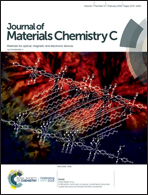Grain configuration effect on the phase transition, piezoelectric strain and temperature stability of KNN-based ceramics†
Abstract
Lead-free 0.985(0.96KNNT–0.04BNKZ)–0.015CZ ceramics were sintered at 1150–1190 °C. The average grain size increases from ∼0.54 μm to ∼1.26 μm on increasing the sintering temperature (Tsinter) from 1150 °C to 1190 °C. The increase of average grain size induces the R/T phase boundary to change to an O/T phase boundary at room temperature. An abnormal region in the ceramics sintered at 1170–1190 °C was observed where fine grains surround coarse grains that are the result of abnormal growth. The fine grains become smaller and their ratio increases, when Tsinter increases from 1150 °C to 1190 °C. The ceramics sintered at 1180 °C with good temperature stability (Te = 120 °C) and optimal room temperature piezoelectric strain (d33* = 482 pm V−1 at 35 kV cm−1) should be attributed to the suitable grain configuration. At Tsinter = 1150–1190 °C, the piezoelectric strain of the ceramics can be improved evidently without deteriorating the temperature stability visibly due to the formation of an abnormal region.



 Please wait while we load your content...
Please wait while we load your content...